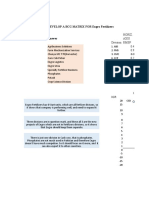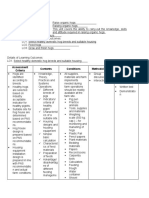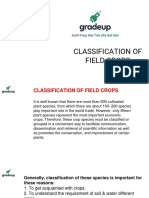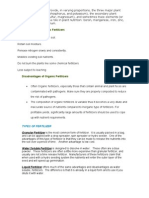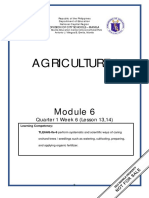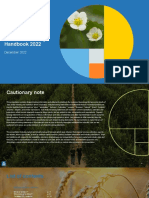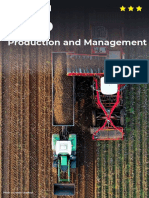0 ratings0% found this document useful (0 votes)
57 viewsACP in Summary LYN Final
ACP in Summary LYN Final
Uploaded by
Kimberly IsmaelThis document provides an overview of the 10 core competencies for the ACP NC 3 agricultural training program. It summarizes the key tasks and considerations for each core competency, including land preparation, post-harvest activities, plant nutrition, weed control, integrated pest management, establishing and maintaining crops, harvesting, seed storage, and vertebrate pest control. Safety protocols are also outlined.
Copyright:
© All Rights Reserved
Available Formats
Download as PPTX, PDF, TXT or read online from Scribd
ACP in Summary LYN Final
ACP in Summary LYN Final
Uploaded by
Kimberly Ismael0 ratings0% found this document useful (0 votes)
57 views18 pagesThis document provides an overview of the 10 core competencies for the ACP NC 3 agricultural training program. It summarizes the key tasks and considerations for each core competency, including land preparation, post-harvest activities, plant nutrition, weed control, integrated pest management, establishing and maintaining crops, harvesting, seed storage, and vertebrate pest control. Safety protocols are also outlined.
Copyright
© © All Rights Reserved
Available Formats
PPTX, PDF, TXT or read online from Scribd
Share this document
Did you find this document useful?
Is this content inappropriate?
This document provides an overview of the 10 core competencies for the ACP NC 3 agricultural training program. It summarizes the key tasks and considerations for each core competency, including land preparation, post-harvest activities, plant nutrition, weed control, integrated pest management, establishing and maintaining crops, harvesting, seed storage, and vertebrate pest control. Safety protocols are also outlined.
Copyright:
© All Rights Reserved
Available Formats
Download as PPTX, PDF, TXT or read online from Scribd
Download as pptx, pdf, or txt
0 ratings0% found this document useful (0 votes)
57 views18 pagesACP in Summary LYN Final
ACP in Summary LYN Final
Uploaded by
Kimberly IsmaelThis document provides an overview of the 10 core competencies for the ACP NC 3 agricultural training program. It summarizes the key tasks and considerations for each core competency, including land preparation, post-harvest activities, plant nutrition, weed control, integrated pest management, establishing and maintaining crops, harvesting, seed storage, and vertebrate pest control. Safety protocols are also outlined.
Copyright:
© All Rights Reserved
Available Formats
Download as PPTX, PDF, TXT or read online from Scribd
Download as pptx, pdf, or txt
You are on page 1of 18
ACP NC 3 – in summary
Dr. Lynne Rose Oquendo – Jocosol
Learning Facilitator
Basic Competencies
Lead workplace communication
Lead small teams
Develop and practice negotiation skills
Solve problems related to work
activities
Use mathematical concepts and
techniques
Use relevant technologies
Common Competencies
Apply safety measures in farm
operations
Use farm tools and equipment
Perform estimation and
calculations
Core 1- Prepare land for
agricultural crop production
Soil sampling for soil analysis – not too wet,
not too dry, done usually after harvest
Operate tractor (first pass) and harrow (second
pass)
Seed Treatment for corn and rice –
- Corn seeds are mixed with larvin or diafuran, at
least one hour before planting.
- Rice seedlings are treated by dipping their roots at
2% zinc oxide suspension for zinc deficient areas.
Core 2- Implement post-harvest
program
Postharvest procedure or operations such as threshing,
shelling, dehusking, drying, cleaning, grading, packing,
storage, handling and transport of produce
Post-harvest tools, machinery and equipment include
threshers, driers, trailers, knives, gloves, weighing
scales, warehouse, etc.
Post harvest treatments -cleaning, application of
fungicides and insecticides, storing/warehousing.
Packaging materials – will depend on type of crop,
requirement of the buyer, cost
Core 3- Implement plant nutrition
Soil pH – can be determined thru soil analysis, ph meter
Fertilizers are intended to supply nutrients to the plant
Soil ameliorants are intended to neutralize the acidity of the soil such
as lime
Macro elements – Needed by plants in large amounts (N,P,K)
Nitrogen (symbol N) for leaf development and vivid green color
Phosphorus for (symbol P) for root growth
Potassium (symbol K) for root development and disease resistance
Micro elements - Needed by plants in small amounts (boron, chlorine,
cobalt, copper, iron, manganese, molybdenum, nickel and zinc)
Samples of Commercial fertilizers - Urea, complete, muriate of potash,
ammonium sulphate, ammonium phosphate
Core 4- Control Weeds
Methods to control weeds
- Use of clean (weed- free seeds) planting materials
- Proper land preparation
- Crop rotation
-Irrigation management: flooding
- Solarization/burning
- Selective grazing
- Mulching
- Cover cropping
- Use of herbicides-last option
Harmful effects of weeds
Serves as alternate host for crop diseases
Harbours insects pest
Weed seeds/parts may contaminate
grains/seed produce lowering market value
Contains toxic (allergenic
substances)
Core 5- Apply Chemicals
Examples of Insect Pest - stem borer, leafhopper,
plant hopper, whorl maggot, green leaf borer, army
worm, cut worm, case worm, leaf folder, leaf
miner, aphids, thrips
Examples of Diseases - blast, tungro, bacterial leaf
streak, sheath blight, brown spot, bacterial leaf
blight, grassy stunt, yellow dwarf, rots, mosaic,
chlorotic streaks, rust, die-back, downy mildew
Core
5- Apply Chemicals
Insecticide (insects) –Cymbush, Karate
Fungicide (Fungus)– Armure, Score,
Insect damage -cuts in leaves or crop as a
result of insect feeding. Plant reactions may
include curling, abnormality in size, etc.
Disease damage results to wilting,
yellowing, sudden death
Core 6- Establish agronomic crops
Agronomic crops - cereals (e.g. rice, corn),oilseeds
(e.g. coconut, soybean), fiber (e.g. cotton), grain
legumes (e.g. peanuts, soybeans)
Crop establishment - Use certified seeds and choose a
variety with high yield and market demand which has
been tested in techno demo areas. Follow the local
planting calendar. For rice, the age of seedlings should
be 20-25 days with 1-3 seedlings per hill planted at 20
cm x 20 cm distance.
Core 7- Undertake agronomic crop
maintenance activities
Water Management - Avoid excessive water or drought stress that could
affect the growth and yield of the crop.
- For RICE, achieve 3-5 cm water depth every irrigation time from early
tillering until 1-2 weeks before crop maturity or harvest. Drain water or
stop irrigation 1-2 weeks before harvest
- For CORN, irrigation should be done right after planting and at the
following days after planting (DAP: 12-15, 25-30, 40-45, 55-60, 70-75)
Thinning- removal of some plants, or parts of plants, to make room for
the growth of others but does not involve the cutting of the whole tree.
Pruning - Selective removal of parts of a plant such as branches, buds,
or roots
Sanitation of tools – Sterilization, dipping of the tools in alcohol, regular
fungicide, or chlorine solution.
Core 8- Undertake agronomic crop
harvesting activities
Crop Harvesting
Depends on the maturity of the crop (days after planting, days after
heading), physical characteristics (hardness, size, color, odor),
moisture content.
Harvest palay when 80% of the grains are mature. Grains at the tip of
the panicle must be hard and golden yellow, even while grains near
the base of the panicle are less mature. Harvest when 20% of the
grains at the base of panicle are in hard dough stage. Moisture content
should be at 20-25% in wet season and 18-21% in dry season.
Corn is ready for harvesting when a black layer develops at grains'
point of attachment to cob, kernels are glazed, and the leaves and
husks are dry.
Conduct ocular inspection; maturity tests; moisture content; taste test
Core 8- Undertake agronomic crop
harvesting activities
Harvesting Tools
Maturity testing tools such as moisture meter and other
tools like harvesting shears, bolo or knives; gloves;
reapers and harvesters; Packaging materials like sacks,
net bags, basket, etc.
Quality of Produce
The produce should not be left exposed to the elements
(e.g. excessive heat or rain) for a long time. Proper
handling and post-harvest operations must be practiced
to avoid damage to the crop.
Core 9- Save, prepare and store
agricultural seed
Seed Testing
Seeds are tested for purity, moisture content, germination,
mixtures of other varieties, disease organisms, etc.
To ensure their health and high quality to improve crop
yields, disease organism before they are stored and sown in
the field to avoid harmful organisms travelling from infected
to non-infected areas within a country or across international
boundaries
Pest Control
Weevil can be prevented by spraying or dipping sacks in
insecticide solution and drying them before filling with seeds.
Core 10- Implement vertebrate pest
control
program
Rat Control measures
-Cutting weeds along dikes and canal banks and adjacent waste
areas removes cover which rats need to survive
- Destroy all breeding sites of rodents
- Sustained baiting with acute poisons is also desirable.
Signs of rat infestation – Eaten plants, foot steps in
wet paddy, holes in paddy, trace of rodent waste
Baiting stations- 5-10 spaced 50 meters apart
Common brands of rodenticide - Racumin, Zinc
Phosphide
COC 10- Implement vertebrate pest
control program
Do not use mixing cans or spoons used to
measure pesticides for any other purposes.
Mix chemicals outside the house.
- Do not inhale the dust and vapors.
- Do not eat, drink, or smoke while handling
chemicals.
- Wash hands thoroughly each time you finish
your work.
THANK YOU for the friendship
SOAR HIGH, MY DEAR TRAINEES
Lots of GOOD LUCK ON YOUR ASSESSMENT
Keep safe everyone!
You might also like
- Integrated Pest Management TESDADocument14 pagesIntegrated Pest Management TESDALarino Namit100% (1)
- The Final Syllabus On Organic AgriDocument26 pagesThe Final Syllabus On Organic Agrixtine-rey Quinto100% (1)
- DEVELOP A BCG MATRIX FOR Engro Fertilizers: Horiz. Axis Division RMSP 0.4 0.9 0.2 0.8 0.8 0.6 0.7 0.5 1Document2 pagesDEVELOP A BCG MATRIX FOR Engro Fertilizers: Horiz. Axis Division RMSP 0.4 0.9 0.2 0.8 0.8 0.6 0.7 0.5 1UmarNo ratings yet
- Produce Organic Vegetable-1Document39 pagesProduce Organic Vegetable-1baitan dadiganNo ratings yet
- Organic Vegetable ProductionDocument12 pagesOrganic Vegetable Productionjeffrey sarolNo ratings yet
- Organic Production of Coffee, Okra, Tomato, Mango and BananaFrom EverandOrganic Production of Coffee, Okra, Tomato, Mango and BananaRating: 3 out of 5 stars3/5 (1)
- Facilitators’ Guide Book for Farmers’ Field SchoolsFrom EverandFacilitators’ Guide Book for Farmers’ Field SchoolsNo ratings yet
- Agri - Crop NC IIDocument109 pagesAgri - Crop NC IIbaitan dadiganNo ratings yet
- The ConferenceDocument83 pagesThe ConferenceAnonymous Nf6cQ7WNo ratings yet
- 6 - Training Calendar ACP NC IIIDocument11 pages6 - Training Calendar ACP NC IIIrcsalvadorNo ratings yet
- Apr-Housing and Equipment inDocument45 pagesApr-Housing and Equipment inRayge HarbskyNo ratings yet
- Identify Maturity IndicesDocument4 pagesIdentify Maturity Indicesrelan.fabricante001No ratings yet
- G. Seed Production TechniquesDocument52 pagesG. Seed Production TechniquesPETER PAUL ESTILLERNo ratings yet
- Introduction To Postharvest HandlingDocument27 pagesIntroduction To Postharvest HandlingNemie Rex Sukil-ap GuerzonNo ratings yet
- HOR 111 Lectures FinalDocument55 pagesHOR 111 Lectures FinalalekhyaNo ratings yet
- Swine ProductionDocument73 pagesSwine ProductionDUGONG PHNo ratings yet
- Raising Organic Small RuminantDocument16 pagesRaising Organic Small Ruminantroger rada100% (1)
- SAG - Agricultural Crop Production NC IIDocument7 pagesSAG - Agricultural Crop Production NC IIRocz RocoNo ratings yet
- UNIT 3 - Produce Organic FertilizerDocument50 pagesUNIT 3 - Produce Organic FertilizerBest SchoolNo ratings yet
- CROP SCIENCE 1 Lab ActivityDocument4 pagesCROP SCIENCE 1 Lab ActivityJoann JacobNo ratings yet
- V. Physical and Mechanical ControlDocument6 pagesV. Physical and Mechanical ControlGellie AngelesNo ratings yet
- OAP - Elective CompetenciesDocument40 pagesOAP - Elective CompetenciesFe Marie JisonNo ratings yet
- SG LO1 Apply Control Measures (IBICCI)Document2 pagesSG LO1 Apply Control Measures (IBICCI)Mayiendlesslove WhiteNo ratings yet
- Site Characterization and SelectionDocument9 pagesSite Characterization and SelectionChristian Delas HerrasNo ratings yet
- Dokumen - Tips - Standard Operating Procedure Knapsack Sprayer Calibration Is The Preparation andDocument6 pagesDokumen - Tips - Standard Operating Procedure Knapsack Sprayer Calibration Is The Preparation andJanu MaglenteNo ratings yet
- Core Modules of Instruction Agriculture NC IIDocument32 pagesCore Modules of Instruction Agriculture NC IIMEAMALLORCANo ratings yet
- Raise Organic Small RuminantsDocument42 pagesRaise Organic Small RuminantsRegie MacayaNo ratings yet
- Lec 1 Site SelectionDocument26 pagesLec 1 Site SelectionEric Coluban AlipanNo ratings yet
- 2 Plant CropsDocument46 pages2 Plant CropsRyan Paul CaalemNo ratings yet
- Raise Small RuminantsDocument10 pagesRaise Small RuminantsRegie MacayaNo ratings yet
- Evidence Plan SwineDocument12 pagesEvidence Plan Swinedaniel,jr BALDOZNo ratings yet
- Ruminants Uc4Document55 pagesRuminants Uc4Rayge HarbskyNo ratings yet
- GPP Presentation Day 2 (Maynard M. Baluyut)Document113 pagesGPP Presentation Day 2 (Maynard M. Baluyut)maynardNo ratings yet
- Weeds ScienceDocument13 pagesWeeds Sciencevanessa jean patindolNo ratings yet
- Crop Maintenance Machinery and Equipment Operations: SprayerDocument10 pagesCrop Maintenance Machinery and Equipment Operations: SprayerKelly EstilongNo ratings yet
- Organic Agriculture-Bureau of Agriculture-PhilippinesDocument50 pagesOrganic Agriculture-Bureau of Agriculture-PhilippinesElisha TajanNo ratings yet
- Classification of Field Crops 39Document20 pagesClassification of Field Crops 39GaDaR VinesNo ratings yet
- Annex A. Prospectus 1 Diploma in Agriculture TechnologyDocument1 pageAnnex A. Prospectus 1 Diploma in Agriculture Technologyjoylyn franNo ratings yet
- Pns Bafps 49 2011 Code of PhilgapDocument27 pagesPns Bafps 49 2011 Code of PhilgapAlexander Julio ValeraNo ratings yet
- GraftingDocument38 pagesGraftingISHITA GUPTANo ratings yet
- Advantages of Organic FertilizersDocument2 pagesAdvantages of Organic FertilizersAmaresha RoutarayNo ratings yet
- Equipment Type Shredder Equipment Code SCS2052.1 Location Practical Work Area Operation ProcedureDocument31 pagesEquipment Type Shredder Equipment Code SCS2052.1 Location Practical Work Area Operation ProcedureAnna Clarissa VillaverNo ratings yet
- SAG Agricultural Crop Production NC IIIDocument13 pagesSAG Agricultural Crop Production NC IIIVernon Akiron CambaNo ratings yet
- SG LO3 Water Crops (UAS)Document4 pagesSG LO3 Water Crops (UAS)Mayiendlesslove WhiteNo ratings yet
- Essential Elements and Their Distribution in The ProfileDocument25 pagesEssential Elements and Their Distribution in The ProfileFeodore Abrion ReplikoNo ratings yet
- RCEF FFS and PTD Activities Protocol Revised 01.23.2020Document23 pagesRCEF FFS and PTD Activities Protocol Revised 01.23.2020Linchoco Rice Dealer100% (1)
- W Session-Plan Care and Maintain CropsDocument7 pagesW Session-Plan Care and Maintain Cropsanna luna llubit100% (1)
- Syllabus On Agricultural Crop Production Nc11 BrentwoodDocument4 pagesSyllabus On Agricultural Crop Production Nc11 BrentwoodRhomar GamboaNo ratings yet
- TesdaDocument59 pagesTesdaJohn Patrick Pascual80% (10)
- Organic Agriculture 2Document61 pagesOrganic Agriculture 2jinian bongcayao100% (1)
- Full-Online Blended Online (/) Distance LearningDocument2 pagesFull-Online Blended Online (/) Distance LearningJean JeanNo ratings yet
- Classification of CropsDocument4 pagesClassification of CropsDanica DayananNo ratings yet
- Postharvest Insect Pest and Disease ControlDocument47 pagesPostharvest Insect Pest and Disease ControlKatrina Famador100% (1)
- ANIMAL PRODUCTION SWINE NC II Handouts All CompetencyDocument13 pagesANIMAL PRODUCTION SWINE NC II Handouts All CompetencyJoy L. ManeraNo ratings yet
- CBC Organic Agricultural NC II New NormalDocument96 pagesCBC Organic Agricultural NC II New Normaljazzy mallariNo ratings yet
- 1 Practical Notes - Sowing and Transplanting of Vegetable CropsDocument6 pages1 Practical Notes - Sowing and Transplanting of Vegetable CropsRubi100% (1)
- Animal Production: Ruminants NCIIDocument23 pagesAnimal Production: Ruminants NCIIMeynard Baptista100% (1)
- Lecture 1 Introducing Organic AgricultureDocument29 pagesLecture 1 Introducing Organic AgricultureAshly Sacdalan ViolandaNo ratings yet
- ORGANIC AGRICULTURE PRODUCTION NCII. Raise Organic Small RuminatsDocument3 pagesORGANIC AGRICULTURE PRODUCTION NCII. Raise Organic Small RuminatsCarolina MagnoNo ratings yet
- Lecture 1 Crop ProductionDocument22 pagesLecture 1 Crop ProductionCharles AndevukuNo ratings yet
- Pre Test: Crop ScienceDocument6 pagesPre Test: Crop ScienceKimberly IsmaelNo ratings yet
- Question For Crop Production by Nenita B. BaldoDocument2 pagesQuestion For Crop Production by Nenita B. BaldoKimberly Ismael100% (2)
- Review Questions For Weed ScienceDocument2 pagesReview Questions For Weed ScienceKimberly Ismael0% (1)
- FINAL DRAFT Research Toolkit For DA National Survey Project 04.04.2021Document68 pagesFINAL DRAFT Research Toolkit For DA National Survey Project 04.04.2021Kimberly IsmaelNo ratings yet
- Crop Protection - Pesticide Calculation Ronel D. Roberto, Lic. AgrDocument5 pagesCrop Protection - Pesticide Calculation Ronel D. Roberto, Lic. AgrKimberly Ismael82% (11)
- How To Use The Kish GridDocument5 pagesHow To Use The Kish GridKimberly IsmaelNo ratings yet
- Practice Test in Crop Science (Clsu)Document32 pagesPractice Test in Crop Science (Clsu)Krisburt Delos Santos100% (1)
- Survey Information and Respondent Consent FormDocument32 pagesSurvey Information and Respondent Consent FormKimberly IsmaelNo ratings yet
- Agronomy: B. Sc. (Hons) AgricultureDocument31 pagesAgronomy: B. Sc. (Hons) AgricultureMane omprakashNo ratings yet
- Literature ReviewDocument4 pagesLiterature ReviewAmirul HanifNo ratings yet
- Green ManuringDocument12 pagesGreen ManuringAnil AngadiNo ratings yet
- AGRI Module 1Document6 pagesAGRI Module 1mae ramosNo ratings yet
- Plant Growth TestDocument2 pagesPlant Growth Testasmarouf2021No ratings yet
- SoybeanDocument112 pagesSoybeanaicel sagaNo ratings yet
- Brochure On Forage Production (Establishment Management, Harvest)Document35 pagesBrochure On Forage Production (Establishment Management, Harvest)VilasNo ratings yet
- TLE-TE 6 - Q1 - Mod6 - AgricultureDocument22 pagesTLE-TE 6 - Q1 - Mod6 - AgricultureSACATA NATIONAL HIGH SCHOOL100% (5)
- What Are Mycorrhizal Fungi?: Mark HowiesonDocument31 pagesWhat Are Mycorrhizal Fungi?: Mark HowiesonIrine Puspa NingrumNo ratings yet
- Lectures 14 Urea - Part 1Document8 pagesLectures 14 Urea - Part 1Nour Saad EdweekNo ratings yet
- Dr. Lawong Balun: Specialty: - PHD in Plant Ecophysiology - Ecologist - Botanist - SoilsDocument43 pagesDr. Lawong Balun: Specialty: - PHD in Plant Ecophysiology - Ecologist - Botanist - SoilsAndy PikiNo ratings yet
- Technology Impact On Agricultural Productivity: A Review of Precision Agriculture Using Unmanned Aerial VehiclesDocument12 pagesTechnology Impact On Agricultural Productivity: A Review of Precision Agriculture Using Unmanned Aerial VehiclesRanjani VasuNo ratings yet
- ChitosanDocument7 pagesChitosanYonatan AdiNo ratings yet
- Fertilizer Industry Handbook 2022 PDFDocument109 pagesFertilizer Industry Handbook 2022 PDFtheredcornerNo ratings yet
- Nitrates and Sulphate Fertilizers: Leading Fertilizer Know-HowDocument19 pagesNitrates and Sulphate Fertilizers: Leading Fertilizer Know-Howexergy 33No ratings yet
- Implementation of Organic Fertilizer of Humus and Chemical Fertilizer Fructifol in The Effectiveness of Growth of The Fodder Maize (Zea Mayz)Document6 pagesImplementation of Organic Fertilizer of Humus and Chemical Fertilizer Fructifol in The Effectiveness of Growth of The Fodder Maize (Zea Mayz)Sergio RiveraNo ratings yet
- Research Paper (Banana Peel)Document8 pagesResearch Paper (Banana Peel)Teremie Joseph Ceballos ObadoNo ratings yet
- Miscanthus PDFDocument52 pagesMiscanthus PDFDanny EtieveNo ratings yet
- Pub 3084 Rice Disease Slow ResDocument6 pagesPub 3084 Rice Disease Slow Reslynmaria madronaNo ratings yet
- The Use of Organic and Inorganic Fertilizers and Its Effect On The Quality of Corn Products in The Philippines: A ReviewDocument19 pagesThe Use of Organic and Inorganic Fertilizers and Its Effect On The Quality of Corn Products in The Philippines: A ReviewAziz KudaratNo ratings yet
- (E-Module) Bio - Ch1 - Crop Production and ManagementDocument58 pages(E-Module) Bio - Ch1 - Crop Production and ManagementAryan SinghNo ratings yet
- Assignment 2 Summary Defining Agroecology and Gliessman 2014 Chapter 1Document4 pagesAssignment 2 Summary Defining Agroecology and Gliessman 2014 Chapter 1Eduardo KunNo ratings yet
- Principles of AGR 1st Semester BB Sir Final 063Document108 pagesPrinciples of AGR 1st Semester BB Sir Final 063Purna DhanukNo ratings yet
- 8 Holiday HWDocument4 pages8 Holiday HWShashwat SinghNo ratings yet
- Av Covo Rugare Gold PLUSDocument1 pageAv Covo Rugare Gold PLUSBenjamin TondondoNo ratings yet
- 24 Crop Rotation Principles TypesDocument17 pages24 Crop Rotation Principles TypesUmer Nawaz100% (1)
- Silage MakingDocument3 pagesSilage MakingMark Cielo Torceno CamerosNo ratings yet
- M.SC PresentationDocument20 pagesM.SC PresentationBN CreationNo ratings yet
- Soilsystems 07 00017 v2Document34 pagesSoilsystems 07 00017 v2SagniNo ratings yet


